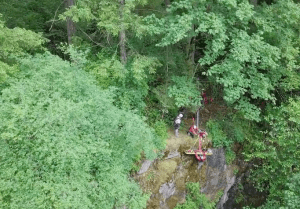Hey all, as I have been going through our plans for the coming 5 months (the rest of 2018), I noticed there have been “windows of thought” where the layout of courses, technical content, equipment reviews and generally the flow of information (from the field) could use some improving and this got me thinking about something.
Science and Imagination and how they work together. My question isn’t which is more important (science or imagination) nor which comes first. Like an old adage asks… “which came first, the chicken or the egg”? Well, the chicken of course. Eggs don’t beget chickens; Chickens beget chickens. It is at this point that one must come to the conclusion… “how then did chickens come about”? This brings in the flurry of science and imagination. I love this!!!
So math (science) says that 90+10=100. The concept is sound correct? Except only in a vacuum is this true. A unit measure of “one (1)” defines the units of 90 and 10. However, we neither live nor survive in a vacuum and the best view for vision is always above the crowded confusion of acceptable.
Solutions Should Be Defined According The Units Being Measured and What The Outcomes Must Be
Therefore, when discussing rigging and rescue solutions, a unit measure is not so easily defined. A 3:1 MA technically is only correct in the sense of the “pulley system”. The T Method may say yes, the Ideal Mechanical Advantage is likely not… and when you add the “hauler” into the equation which is the Input Force (and thus is part of the MA), then most definitely not. Why? Because no one hauls at the same force (nor can you actually standardize a hauler) and when you add multiple haulers, then your math is completely off. Expand this to 4:1, 9:1 and so on. You get the point right? We need to think about this stuff before we build things.
I sat down this morning to sketch out our upcoming addendum’s for some of the Rigging Lab Academy courses… and a thought occurred to me: Even if we (RLA or anyone) could teach 100% of every conceivable combination of techniques and theories, the techniques will be questioned when the theories are in doubt. So what happens here? This is where the adventure starts. The “great” will always explore the unexplored, while the “good” will always play it safe and leave well enough alone. However.. is safe really safe?
Steve Crandall says that “10% of the solutions within rope rescue and rigging will be effective, safe and easy to learn. Another 25% would be safe, effective and simple and another 25% could be effective and safe but complex in nature”. So 60% of our possible solutions would be deemed effective. There is a huge difference between learning and implementing 10% of what is out there vs 60% of the possibilities. Is it possible to have access to all of the 60% and learn (plus retain) it all? I think we can!
Is the remaining 40% really dangerous? I mean if all instructors and trainers are from the same material… why is there unsafe, dangerous or even “impractical” rigging systems? I am getting into the minutia here but hang in there. I believe the question isn’t “what is being taught” but more “where and how” the information is being delivered and too “who”.
How Important Are Guidelines?
Guidelines from NFPA, AMGA, MRA, OSHA, SPRAT, IRATA ect… are all practical and all work right? All have been committee-ized. Can an AMGA rock guide teach NFPA technician level courses? Of course. Would or could a fire guy teach rope access…? Yes! How about a SPRAT guy teaching an AMGA SPI course? Sure! They are not exclusive and when “best practices” are taught within the correct environment, then you have a match. However, what if a fire guy taught the operations guidelines to team of AMGA/MRA members… would this fly? Maybe and then again, likely not. Why? Religion, Politics and Rope Rescue Rigging Systems… they are all a system of beliefs or world views.
When the foundations of “best practices” were employed (be it guides, fire service, mountain rescue ect…) the leadership of that given community had a certain “field of vision” (and imagination) and pretty much anything outside of this “view” could be considered taboo. If people lowered their guard and stepped into someone one else’s world, they would recognize that our own filters always constrain “best practices”. This is always meant for the good, but when logic (or science) prevails over imagination and common sense, then growth is lost and so is creativity.
So teams that practice only the 10% (safe, easy to learn and effective) are forced to pressure cook their understanding into everything that comes their way (a vacuum). This will never work. However, the reverse has its challenges as well. To attempt to learn everything because “you never know what will be thrown your way” is a recipe for disaster as well, because rarely can anyone (team or individual) commit 100% of their time and resource to know 100% of everything and retain it all. It is a losing battle.
A more balance and adventurous approach would be to consider a 60-40 endeavor (going back to the original 60%). Map out your team and individuals… this might be operations vs technician level SOPs or team vs individual skill levels. Consider your culture, your equipment, your commitment, agreements, long term and short term goals and all other resources. Gather all of this and begin the process of mind-mapping it out.
Start with imagination first. The moment you start with rules (science), you cripple yourself and your team by not allowing the journey to take place. The constraints will come into play but only after some serious expansion of “what would it look like if…”? Really consider what a “dream team” would look like and how to get there. Running a cost benefit analysis… but do it only after you visioned it all out.
Visionary Science… Fire guys, you remember Alan Brunacini right?
Now bear in mind, this alone is hard when the logical person can’t do this or a “loose canon type visionary” can’t commit to constraints or boundaries. This is the beauty of what I call “visionary science”. It is a rare person that builds through vision and can strategize the science as well (and Alan Brunacini did this well for the fire service). Remember a goal is not an objective. Objectives give definition to the goal by building it into steps. But the grand vision must take place first. Can you run full systems and still have only a few show up on the call? Play it out. What needs to take place? What equipment and techniques need to be altered to

make this happen? The only way to grow is eliminate all areas that you run to in order to feel safe. Be willing to make mistakes. Growth is painful, but it won’t stay that way.
Protecting the people and seeing past our walls (obstacles), while building a future that will endure is the mark of good leadership. Isn’t this what we want in our leaders? Do we really want people protecting their own safety nets or extending their own insecurities simply because they refuse to understand or listen? Harsh words I know, but it is true. And yet the reverse is true as well. Visionary (imaginative) solutions without accountability to boundaries will lead to confusion. There is no growth when Confusion has entered the room.
Our world is very different today than it was 10 years ago. Events move much faster and people have a tremendous amount of stress in their lives. Professional rescuers (paid and non paid alike) must be guided with pinpoint accuracy. Attention spans are shorter and “making the complicated simple” is a skill that we all need to master. Sometimes unpacking the clutter of misunderstanding means some painful and frustrating moments. Pushing through a crux decision means that a bias needs to be tossed for a greater understanding.
Clarity
Because none of us are created equal… we all carry a part of the solution with us. The job of a guide or trainer is to pull the gold out of others. This means that not all “guiding or training services” are equal. Within leaders not all leadership methods work all the time and as humans, we have an innate desire to help right? So we serve others and allow others to serve us and when we allow this process to come full circle, we will gain a huge advantage we hadn’t seen or understood before and this is called Clarity and clarity is the quality of being easy to see or hear; sharpness of image or sound… It just works!
When all is said and done, it is clarity we are after. Systems are a group of thoughts, skills, elements or structures that together perform one or more vital functions seamlessly, efficiently and effectively. This is how a team grows, but the individual will grow during, before and after. The Chicken Or The Egg?
Call us or email us… If you are needing a little or a lot of assistance in getting you and or your team to a place of “high performance”… we can help. You guys are World Changers! Lets do this!
[thrive_lead_lock id=’50072′]Hidden Content[/thrive_lead_lock]
Peace on your days…
Lance











4 thoughts on “90+10 Does Not Equal a 100% Solution: Treat It All as an Adventure”
385106 260301You appear to be very professional within the way you write.::~ 523596
I’ll immediately grab your rss as I can not find your email subscription link or e-newsletter service. Do you have any? Kindly let me know in order that I could subscribe. Thanks.
881401 758749This really is a fantastic web page, could you be interested in doing an interview about just how you developed it? If so e-mail me! 921474
Hi there, simply turned into aware of your weblog thru Google, and found that it’s really informative. I am gonna watch out for brussels. I’ll be grateful when you proceed this in future. Lots of other folks shall be benefited from your writing. Cheers!
Comments are closed.